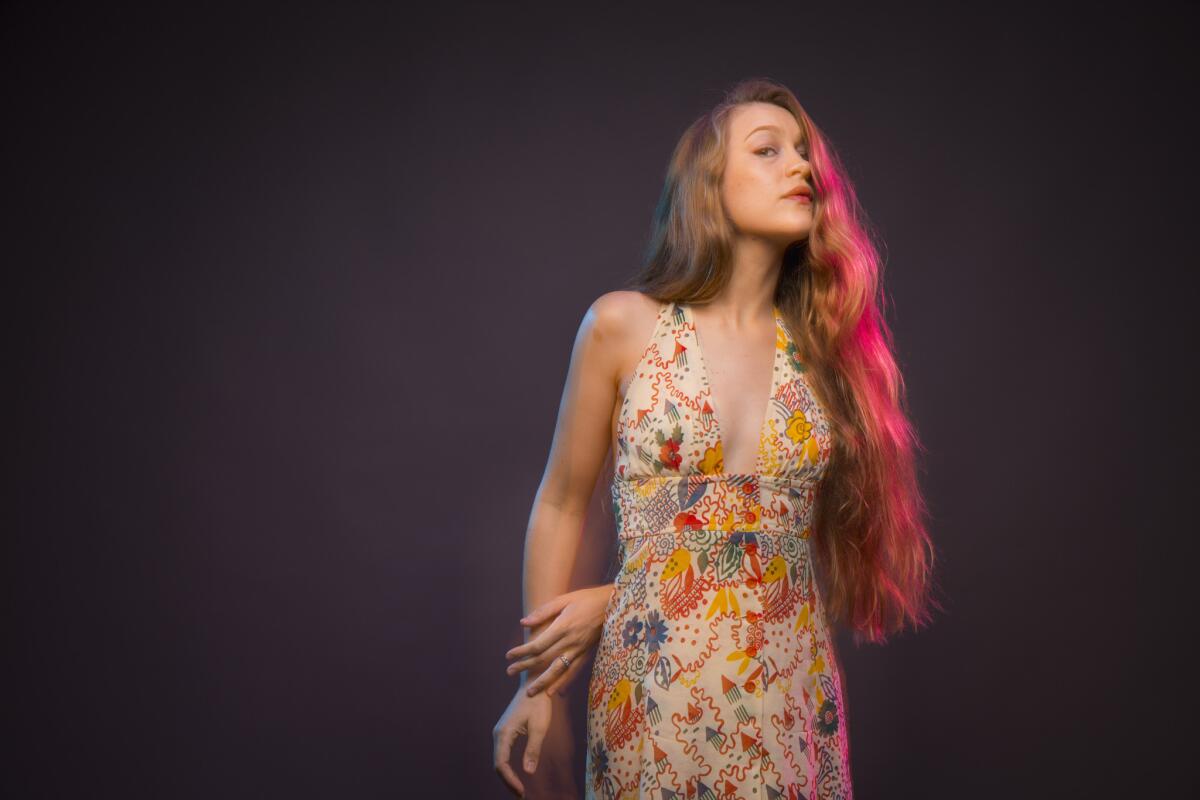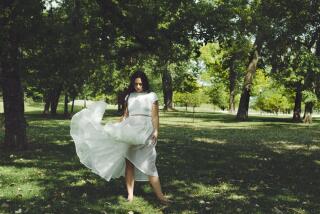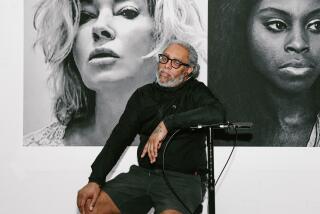Q&A: Joanna Newsom geeks out on the secret weapon of ‘Divers’ -- the mixing board

Joanna Newsom’s fourth album, “Divers,” was released Friday.
The musician Joanna Newsom’s fourth album, “Divers,” arrived Friday to a devoted fan base eager to start studying its 11 songs. The highly anticipated record was mostly created in Los Angeles and recorded by Steve Albini and Noah Georgeson. It took nearly four years to make.
Her fans are a patient lot. In the decade-plus since the release of her studio debut, “The Milk-Eyed Mender,” Newsom has established herself as an instrumentalist, vocalist and composer, and that triple threat has drawn legions of peers eager to collaborate.
SIGN UP for the free Essential Arts & Culture newsletter >>
For “Divers,” Newsom immersed herself more deeply than ever into another discipline within the process: mixing the album. The crucial step involves arranging the individual tracks and instruments just so, layering sounds, shifting frequencies, adding texture, making a whole out of the parts. Working alongside Georgeson, her longtime engineer, Newsom said the mixing took four months, as opposed to the two-week process of her earlier records.
During a recent conversation with Newsom over lunch, I asked her about the process of transforming the instrumental and vocal takes into a cohesive whole.
You recorded this in Los Angeles, which must mean you convinced Steve Albini to leave Chicago for a while.
I know. He’s done it twice for me. He complains the whole time.

Really?
He jokingly complains about L.A. He’s not a fan of L.A. But he certainly didn’t complain while we were recording. He was a pure joy to work with every time. He’s one of my favorite people on the planet. I love Steve.
This record is beautifully mixed. Can you describe that process, and how your approach to mixing your music has evolved over the years?
The first time I made a record, I had no opinion on mixing. With “The Milk-Eyed Mender,” Noah mixed it entirely. The next time I made a record [“Ys”] I started learning about what matters to me in a mix from watching Jim O’Rourke mix the album. And when I say, “watching him mix,” I don’t mean that literally.
Part of the way he works is that he’ll want to spend six hours alone with the songs before I give any notes. And sometimes I wouldn’t have that many notes to give, and sometimes I’d have a lot of notes to give and it would mean going back a little bit and redoing some things. But he likes to get his definitive take — I think he goes into a state where it’s not constructive to have notes and comments.
That’s how he works and it creates beautiful results, but I think somewhere around that process I started to realize that I had some really strong opinions about mixing, and then when I mixed the third record, “Have One on Me,” I mixed it with Noah Georgeson again.
I mean, he mixed that album, but I started having a lot more notes. It started being a lot more of a conversation at the beginning of a song, at the outset, what we wanted it to feel like, what some other references might be.
I started to realize that I had some really strong opinions about mixing, and then when I mixed the third record, “Have One on Me,” I mixed it with Noah Georgeson again.
— Joanna Newsom
For each song?
Not only for the song as a whole, but specific drum references or specific guitar references. Specific conversations about the ways in which the pan, or the ways in which the various factors related to the imaging of the record also might relate to the narrative, or also might relate to the mood of the songs.
That was also when I started spending a lot more time listening and relistening to the songs and sort of tweaking it based on more concrete notes than I would even have known to be able to generate in the past.
This record, it was like all hell broke loose — but in a good way. I had this sense that this was an album that was going to become itself in the mix — that there were so many disparate elements and strange sort of piles of options that had accumulated, not all of which would have ended up being useful.
That sounds overwhelming.
There was so much having to do with not only how each instrumental element interrelates with or interacts with an individual song, but also how the overall instrumental palette and character of each song interacts with the instrumental palette and character of the song that precedes it and the song that follows it — and sort of presents a kind of topography for the album as a whole.
There was a lot of sifting through, editing, removing in some cases, of parts, and we also added a lot of stuff at the mixing phase. Brought another keyboard in, brought another harp in, added vocal harmonies as the album started to reveal itself more and more.
Noah would ask me basic questions about how I wanted an individual song to feel, and then he would spend three hours with it, just setting it, roughly blocking it out in terms of the pan and in terms of the levels.
With you out of the room?
Usually. It kind of wouldn’t matter. It wasn’t the thing of like, ‘This is his take on the song.’ He would just kind of get it. And a lot of that is rooted, just, in his inherent great taste, and some of it was rooted in the fact that we’ve worked together long enough that we have a little bit of shorthand. ‘This is how she likes her voice to sound and sit, this is how she likes the piano to sound and sit.’
So he would kind of block it out and then I would take maybe six passes and I would have a lyric sheet -- that was the easiest way to do it -- and I would make notes over each lyric. “Trombone up” or “I want the strings to move back in space as the crescendo happens -- I want them to be receding in space.” “I want there to be more reverb here.” “I want this to suck down to a suddenly dry vacuum in this spot.” Or make a note that we need a vocal harmony here.
We’d do like six passes and also kind of trace the lines of vocals throughout. Individual words I wanted quieter or louder. And then Noah would come and I would convey the notes and we would go through bit by bit and tweak it. And then I would take another pass at it. I would take it home, and make more notes.
It was totally immersive, and I’m sure slower, because as strongly as I felt about these things, I’m also new to these things, so it’s not my hands on the knobs of faders and whatnot.
It’s hard to consider you being “new” to this, given your experience.
Well, I’m new to truly mixing a record. It’s a really different thing. I think there are some musicians who go through their whole career without having a whole lot of opinion about the mix -- and there’s nothing wrong with that. And it’s possible that maybe on my next album I’ll be like, “You can mix it,” because for whatever reason maybe the next album will have a different set of imperatives. But this one, I had a really strong opinion about every note, every beat, every word.
This conversation has been edited for length and clarity.
Follow me on Twitter: @liledit
ALSO:
Why Paul McCartney’s obscure and dissed ‘Temporary Secretary’ is the secret weapon of DJs worldwide
Spotify woos Joanna Newsom with invite: ‘We’d love to work with her too’
Five videos that prove Los Lobos has earned a Rock and Roll Hall of Fame nod
More to Read
The biggest entertainment stories
Get our big stories about Hollywood, film, television, music, arts, culture and more right in your inbox as soon as they publish.
You may occasionally receive promotional content from the Los Angeles Times.







